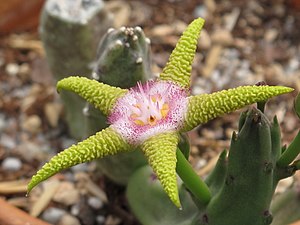Stapelia flavopurpurea
| Stapelia flavopurpurea | ||||||||||||
|---|---|---|---|---|---|---|---|---|---|---|---|---|

Stapelia flavopurpurea |
||||||||||||
| Systematics | ||||||||||||
|
||||||||||||
| Scientific name | ||||||||||||
| Stapelia flavopurpurea | ||||||||||||
| Marloth |
Stapelia flavopurpurea is a species of the subfamily of the silk plants (Asclepiadoideae). Their distribution area in southern Africa includes Namibia , Botswana and the Republic of South Africa .
description
Vegetative characteristics
Stapelia flavopurpurea grows as a perennial succulent plant and forms low, clump-like growth forms . The stem succulent shoot axes are up to about 10 cm long / high and four-ribbed in cross section with a diameter of about 1 centimeter. Specimens in ideal locations can also get significantly larger. The sides of the shoot axes are flat or slightly concave. The warts are indistinct, the leaflets obsolete. The pale minor leaf rudiments are blunt.
Generative characteristics
The flowers are usually solitary, or the inflorescence has few flowers and are randomly distributed. The flowers point outwards. The flower stalk or inflorescence stalk is strong and reaches a length of about 3 centimeters (rarely more).
The flowers of Stapelia flavopurpurea are smaller than those of most other Stapelia species and they lack the unpleasant smell that is so typical of this genus. The hermaphroditic flowers are radial symmetry , five-fold and spread flat with a diameter of 3 to 4 centimeters.
The five petals are fused at the base, the central part is funnel-shaped. A broad ring around the central depression of the crown to the base of the corolla lobes is very hairy. The club hair ( trichomes ) are white to dark purple-red. The lanceolate petal lobes measure 1.3 to 1.6 centimeters in length. The edges are strongly curved outwards. They are bald on the outside or only weakly covered with downy hair. On the inside, they mainly have wrinkles running transversely to the longitudinal axis. The wrinkles are often finely roughened. The crown is pale yellow on the outside, green, yellow, brown or red on the inside.
The secondary crown is whitish. The interstaminal lobes of the corolla are 3 millimeters long, approximately rectangular with a clear tip or slightly notched. You see upright, the sides are curved inwards. The staminal secondary corolla lobes are 6 millimeters long, egg-shaped at the base, subpulate or thread-shaped towards the tip. They stand upright, converge, and then turn outward. The tips are club-shaped. The crescent-shaped pollinia measure 0.7 × 0.3 millimeters.
Chromosome number
The number of chromosomes is 2n = 22.
Occurrence
The not very common, but widespread Stapelia flavopurpurea occurs in Namibia , Botswana and in South Africa (western Karoo to Northern Cape Province ). It thrives between stones at the base of bushes.
Synecology
The flowers of Stapelia flavopurpurea smell slightly different depending on their color. While the reddish forms, like most other species of the genus Stapelia , have a slight smell of carrion, the greenish to yellowish flowers have a fruity-sweet odor. The reddish shapes also have a fruity-sweet smelling component in addition to the malodorous ones. Although some large (carrion) flies are still attracted by the foul-smelling reddish flowers, the majority of the potential pollinators that are attracted are small flies of the family fruit flies (Drosophilidae) and nesting flies (Milichiidae). The flowers give off a scent that smells like an overripe orange or pineapple. On the one hand, fruit flies feed on fermenting plant substances; on the other hand, they also lay eggs on such plant components. Stapelia flavopurpurea thus simulates a potential source of food and a suitable place to lay eggs ("flies deceit"). The pollinia of Stapelia flavopurpurea are much smaller than those of other Stapelia species and can therefore also be torn off by these small flies and transported to another flower.
Systematics
The first description of Stapelia flavopurpurea was made in 1907 by Rudolf Marloth in Volume 18 of the Transactions of the South African Philosophical Society , on p. 48, Plate 5, Figure 1. The specific epithet flavopurpurea alludes to the reddish flower color that forms one form of this species, on.
supporting documents
literature
- Birgit Müller and Focke Albers: Stapelia . In: Focke Albers and Ulli Meve (eds.): Succulent lexicon Volume 3 Asclepiadaceae (silk plants) . Pp. 254-259, Ulmer, Stuttgart 2002, ISBN 978-3-8001-3982-8 .
Individual evidence
- ↑ a b Mark Dimmitt: Stapelia flavopurpurea: A sweet starfish flower . ( Page no longer available , search in web archives ) Info: The link was automatically marked as defective. Please check the link according to the instructions and then remove this notice. (PDF)
- ↑ a b S. Pieter Bester, 2006: Stapelia and, below, Stapelia flavopurpurea at PlantzAfrica .
- ↑ Stapelia flavopurpurea at Tropicos.org. In: IPCN Chromosome Reports . Missouri Botanical Garden, St. Louis
- ^ AK Shukla, MR Vijayaraghavan and B. Chaudhry: Biology of pollen. 133 pp., New Delhi, SB Nangia for APH Pub., 1998 ISBN 81-7024-924-4
- ^ Peter V. Bruyns: Phylogeny and Biogeography of the Stapeliads 1. Phylogeny. In: Plant Systematics and Evolution , 221, 2000, pp. 199-226. doi: 10.1007 / BF01089294